Childbirth is a unique journey for every woman, and for those who have experienced a cesarean section (C-section) in a previous pregnancy, the prospect of a vaginal birth in a subsequent pregnancy can be both hopeful and daunting. Vaginal Birth After Cesarean (VBAC) is a viable option for many women, but it comes with its considerations and requirements. This article aims to provide comprehensive information about VBAC, helping women make informed decisions in consultation with their healthcare providers.
What is VBAC?
VBAC refers to delivering a baby vaginally after having previously had a C-section. This option is considered by many women due to the quicker recovery time, lower risk of complications compared to repeat C-sections, and the desire to experience vaginal birth.
Who is a Candidate for VBAC?
Not every woman who has had a C-section can or should have a VBAC. The likelihood of a successful VBAC depends on several factors, including:
- The type of incision made in the previous C-section. A low transverse incision is typically considered safer for VBAC.
- The reason for the previous C-section and whether that condition is present in the current pregnancy.
- Having had a previous vaginal delivery increases the chances of a successful VBAC.
- Overall health and pregnancy factors.
It’s important to discuss your individual case with your healthcare provider to understand your suitability for a VBAC.
Benefits of VBAC
VBAC offers several potential benefits over a repeat C-section, including:
- Shorter recovery period and hospital stay.
- Lower risk of infection and less blood loss.
- Reduced chance of respiratory problems for the baby.
- Decreased risk of complications in future pregnancies.
Risks of VBAC
While VBAC is successful in 60-80% of cases, it does carry risks, the most significant being the chance of uterine rupture. This rare but serious complication can endanger both the mother and the baby, necessitating immediate medical intervention. Other risks include:
- Labor complications leading to an emergency C-section.
- Endometritis, an infection of the uterine lining.
Preparing for VBAC
Preparation for a VBAC is similar to preparing for any vaginal birth. It includes regular prenatal care, a healthy diet, exercise approved by your healthcare provider, childbirth education classes, and mental preparation for childbirth.
During Labor
If you opt for a VBAC, your labor will be closely monitored for any signs of distress in you or the baby. Continuous electronic fetal monitoring is often used to track the baby’s heartbeat. If any complications arise, a repeat C-section might be necessary.
Making the Decision
Choosing between a repeat C-section and a VBAC is a personal decision that should be made based on accurate information and in consultation with your healthcare provider. Discuss your medical history, the risks and benefits of VBAC, and your personal preferences.
VBAC can be a safe and rewarding option for many women who have had a previous C-section. However, it’s essential to make an informed decision based on a thorough evaluation of your individual circumstances. Collaborate closely with your healthcare provider to understand the best course of action for you and your baby.
Further Reading:
March of Dimes: https://www.marchofdimes.org/find-support/topics/birth/vaginal-birth-after-cesarean
Mayo Clinic: https://www.mayoclinic.org/healthy-lifestyle/labor-and-delivery/in-depth/vbac/art-20044869
